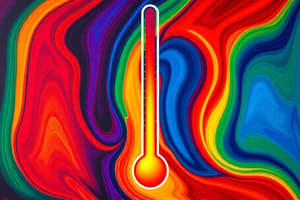Podcast
Questions and Answers
Which surface would likely absorb radiation the fastest?
Which surface would likely absorb radiation the fastest?
- A white, shiny surface
- A black, smooth surface
- A green, matte surface
- A dull black, rough surface (correct)
What happens when an object is a net absorber of radiation?
What happens when an object is a net absorber of radiation?
- It must be emitting more radiation than it absorbs.
- It can only emit radiation, not absorb it.
- It is warmer than the surroundings.
- It must be cooler than its surroundings. (correct)
Why might a shiny surface contribute to lower heat gain?
Why might a shiny surface contribute to lower heat gain?
- It emits less heat than a dull surface.
- It absorbs radiation better than rough surfaces.
- It is a poor emitter of radiation.
- It reflects most of the radiation away. (correct)
Which statement is true regarding heat loss from a black car parked outside?
Which statement is true regarding heat loss from a black car parked outside?
What is a factor that affects the rate of heat loss?
What is a factor that affects the rate of heat loss?
When parked under the sun, why does the black car absorb more heat than the white car?
When parked under the sun, why does the black car absorb more heat than the white car?
What characteristic would make a surface a poor emitter of radiation?
What characteristic would make a surface a poor emitter of radiation?
In what situation is an object neither a net emitter nor a net absorber of radiation?
In what situation is an object neither a net emitter nor a net absorber of radiation?
Which of the following surfaces would typically have the highest rate of heat loss?
Which of the following surfaces would typically have the highest rate of heat loss?
Flashcards are hidden until you start studying
Study Notes
Temperature and Measurement
- Temperature change indicates heat energy transfer, measured accurately with a thermometer.
- The SI unit for temperature is Kelvin (K); Celsius (°C) is commonly used.
- Absolute zero is the lowest temperature at 0 K, representing a complete absence of thermal energy.
Effects of Heat Transfer on Matter
- Heating objects results in expansion, increasing their size (volume).
- Cooling objects leads to contraction, decreasing their size (volume).
- Expansion rates vary: gases expand more than liquids, which expand more than solids.
- Mass remains constant during expansion or contraction, affecting density.
- Density = mass/volume; increased volume results in decreased density, and vice versa.
Heat Transfer Methods
Conduction
- Conduction transfers heat through direct contact between particles without medium movement.
- Solids conduct heat more effectively than liquids and gases due to tightly packed particles.
- Poor conductors, known as insulators, resist heat flow.
- Heat transfer occurs as energetic particles collide and share energy, moving from hotter to cooler areas.
- Metals conduct heat faster than non-metals due to free-moving electrons that enhance energy transfer.
Convection
- Convection transfers heat through the movement of fluids (liquids and gases).
- Heating a fluid causes it to expand, decreasing its density, leading to upward movement (rising).
- Colder, denser fluid sinks, creating convection currents.
- Convection does not occur in solids as their particles cannot move freely.
- Heat transfer in convection relies on density differences within the fluid medium.
Radiation
- Radiation transfers heat without a medium; it can occur in a vacuum.
- All objects can emit and absorb radiation, leading to heat loss or gain.
- Good absorbers of radiation (e.g., black surfaces) also emit radiation well, while poor absorbers (e.g., white surfaces) reflect radiation efficiently.
- An object can absorb more energy than it emits or vice versa, depending on its surrounding temperature.
Factors Affecting Heat Transfer Rates
- Surface properties influence heat absorption and emission:
- Black, dull, and rough surfaces absorb and emit heat effectively.
- White, shiny, and smooth surfaces reflect heat and are poor emitters.
- An object can only be a net emitter or absorber of radiation at any time based on its surrounding temperature.
Example of Heat Absorption in Cars
- A black car absorbs more radiation than a white car, causing it to become hotter when exposed to sunlight, as it is a better radiator of heat in this context.
Studying That Suits You
Use AI to generate personalized quizzes and flashcards to suit your learning preferences.




